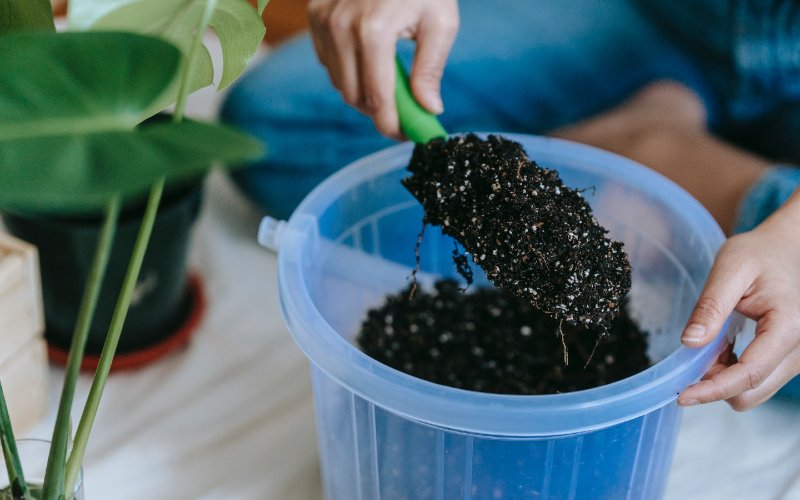7 Types of Potting Soil for Indoor Plants You Can Try Today
-
Ed Malaker
- Last updated:

Understanding potting soil is an important part of gardening, and many different kinds are available. Choosing the right kind for your plant will help it grow faster and produce a larger harvest of flowers and vegetables. If you are confused about the different types of potting soil, keep reading as we list several of the most common kinds and explain when to use them to help you be a better gardener.
The 7 Types of Potting Soil for Indoor Plants
1. Indoor Potting Soil
Indoor potting soil is the best choice for growing plants indoors. It’s light and fluffy and suitable for many of the most common indoor plants, including herbs, peace lilies, and snake plants. It usually contains ingredients that help the soil drain easily but doesn’t have much bark or wood pieces that might make the soil hard to use with small containers.
2. All-Purpose Potting Soil

All-purpose potting soil is one of the most popular kinds because it works well for growing indoor plants, but it will also help improve your garden soil or flower beds. This soil usually contains compost, pine needles, and perlite that help improve soil drainage and aeration. This soil is heavier than indoor soil and might be harder to work with in small pots, but it will still produce healthy indoor plants.
3. Seed-Starting Potting Soil
As the name suggests, seed-starting potting soil is what you need when growing plants from seed. The soil contains ingredients that help keep the seed wet so it germinates. Many brands also help encourage rapid root growth so the plant grows faster and healthier. However, due to the lack of nutrients in the soil, you will need to transplant your plant quickly into a more nutritious potting soil.
4. Moisture-Holding Potting Soil

If you are growing bamboo, ferns, or another plant that requires frequent watering, a moisture-holding potting soil can help the plant stay hydrated longer. It contains peat moss, yucca extract, and other ingredients that help capture and hold excess water that it can release when the soil gets dry. These ingredients work without the soil becoming muddy or soggy, which could damage the roots.
5. Orchid Potting Soil
Orchids are amazing flowers that look great in any home, but their roots require a great deal of air circulation and soil that drains quickly to prevent root damage. Orchid potting soil is the best option for these plants and contains ingredients like coconut coir charcoal that help provide access to moisture without letting the roots get too wet.
6. Cacti and Succulent Potting Soil

For many people, a cactus or succulent is the ultimate house plant because you can just set it and forget about it. However, these plants won’t grow well in standard indoor potting soil and require a special formula with enhanced drainage. This soil usually contains coarse sand, perlite, and other ingredients that let water pass through quickly, and many brands also contain fertilizer that helps the plants get the nutrition that they need.
7. African Violet Potting Soil
The African violet is a colorful plant that will liven up any room, but it can be hard to grow well if you don’t have the right soil. This plant likes acidic soil, so ordinary indoor potting soil won’t work. African violet soil uses peat moss for its excellent water retention and a small amount of limestone to lower the pH and create an acidic environment. Perlite helps the soil drain quickly so the roots don’t get moldy.
Potting Soil Tips and Tricks
How should I store open bags of potting soil?
Tape your bag shut, and place it in an airtight container in a cool, dry place to store it for a short time.
Does potting soil go bad?
Yes. Potting soil often contains many organic materials that can break down in storage. As the ingredients break down, the soil will lose its ability to provide nutrients to your plant.
Can I use old potting soil?
Yes. You can use old potting soil, but you might notice that your plants don’t grow as quickly as they would with fresh soil, especially if the soil is several years old. However, you can improve it by adding organic materials like dead leaves, grass clippings, and small pieces of wood that will break down and add nutrients. Fertilizer will also help your plants grow faster.
Can I mix potting soils?
Yes, you can mix old soil with new soil to improve its nutritional value. You can also mix different kinds of soil to create something more suitable for your plant. For instance, if your indoor potting soil seems to be holding too much moisture, you can mix in cactus and succulent potting soil to help it drain better.
Summary
There are several types of indoor potting soil. The one that you should use will depend on your situation. For instance, if you do a great deal of gardening in addition to keeping indoor plants, an all-purpose potting soil will work everywhere. However, if you only grow indoor plants, indoor potting soil is your best option. It’s easy to work with and most plants grow well in it. If you are growing a cactus, orchid, African violet, or bamboo, purchasing the matching potting soil will improve your plant’s chances of growing strong and healthy.
Featured Image Credit: Syda Productions, Shutterstock
Contents
